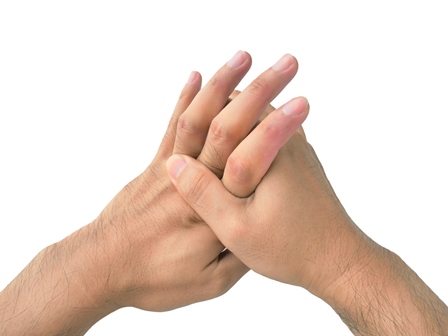Joint Sounds and Noise

Sounds often are used to assist a healthcare professional in making a diagnosis. The characteristic sounds and noise coming from the heart or lungs provide clues to determine whether something is wrong. Listening to the sounds of the stomach and bowels is an important clinical tool in diagnosing bowel obstructions.
Sounds and noise coming from joints are described by various terms: cracking, popping, crepitus, cavitation, grinding, clicking, clunking, and snapping. Much like heart sound or bowel sounds joint sounds can be a normal or can be a sign that something is wrong. Unfortunately listening and observing the sounds and noise of joints is not as helpful in making a diagnosis as it is when listening to heart, lung, and bowel sounds.
A Physical Therapist colleague of mine attempted to conduct research gathering acoustical data from joints in effort to be able to distinguish between normal joint sounds and pathologic sounds. He quickly discovered that it was difficult to obtain funding for research as no J.D. Rockefeller has ever died from joint noise.
There is very limited amount of research on the topic of joint sounds and the research that is available is very conflicting. McCoy (1987) studied 500 individuals half with knee pathology and half with normal knees. Ninety percent of the normal knees had measureable joint noise. The Individuals with the more severe knee joint pathology the joint noise was less audible.
Many clinicians use joint sounds to determine success of treatment. When joints are manipulated either by “self-cracking” or therapeutic manipulation by a healthcare profession a pop can be heard. Again there is controversy regarding whether this noise is good or bad. In a controlled study of individuals with back pain treated with spinal manipulation a pop occurred in 50 of 71 individuals. Both groups those whose joints made a noise and those who did not pop got measurably better. The audible pop that occurs with a spinal manipulation may not be related to improved outcomes.
There are many theories which attempt to explain which tissues are responsible for the joint sounds. Joints are made of two bones, cartilage on the ends of the bones and the joint capsule. The joint capsule is analogous to a strong balloon that surrounds the two bones. Imagine the air has been sucked out of the balloon. There may be a vacuum effect, less pressure inside the capsule than out. The negative pressure inside the joint provides additional stability.
Current thinking is that when a joint pops as when “cracking your knuckle”, the pressure inside the joint capsule is suddenly changed, much like the noise that occurs when forcing air into a balloon that has been stuck together. The joint can be popped again after the vacuum has had time to re-establish itself.
Cartilage covers the ends of bones where they join. The cartilage provides a smooth surface for the two bones to glide on, but the cartilage can wear away, become frayed, or loosen. Flecks or strands of loose cartilage can float around inside the joint capsule, resulting in a coarse grating sound often described as “Rice Krispy’s”. Each time the joint moves, crunching is heard or felt, as opposed to the one time associated with a vacuum like sound.
Another source of noise can be tendons, which attach muscles to bone and overlie the joint capsule. Tendons rub and snap over bony prominence, making noise.
A loud pop or snap that occurs at the same time as an acute injury obviously is a bad sound. A grating, creaking, or popping joint that is swollen, hot and painful obviously indicates a problem. A coarse clicking sound could indicate partial dislocation of the joint, which might lead to degenerative changes later and should be checked.
The question of whether a particular joint noise is pathological or normal still deserves an answer. However, the probability that a joint noise is a sign of a significant problem is very low. If noise is the only sign and there is no pain, swelling, or increased skin temperature, you don’t need to worry. Joint noise with pain should be checked by a health care professional. Joint noise without pain should be monitored over time to see whether other symptoms develop.
Damien Howell Physical Therapy – 804-647-9499 – Fax: 866-879-8591 At-Home, At Office, At Fitness Facility – I come to you, I do home visits Damien@damienhowellpt.com
